Chapter . How Do We Know 3.1
Figure 3.1
Figure 3.1: What is the nature of the genetic material?
In 1869, a German chemist, Johann Frederick Miescher, isolated a novel substance from the nuclei of white blood cells. Since it was derived from the nucleus, Miescher named the substance “nuclein." Unlike proteins, this substance had a high concentration of phosphorus along with nitrogen. Miescher’s colleagues tried to convince him that nuclein was just another protein and phosphorus was a contaminant. However, Miescher was very persistent in his belief that nuclein was a new type of molecule. Eventually, chemical analysis revealed that chromosomes are composed of both protein and Miescher’s nuclein, which we now call deoxyribonucleic acid (DNA).
Of these two substances, nucliec acids and protein, which is the genetic material? In the first half the 20th century, this question was vigorously debated. Almost everyone thought that proteins must be the genetic material, for they knew that the molecule of hereditary had to be able to contain an extraordinary amount of information. It did not seem possible that a simple molecule like DNA could be the genetic material.
This set the stage for the British physician Frederick Griffith in 1928. Griffith was an army medical officer and was attemptng to develop a vaccine against Streptococcus pneumoniae, a bacterium that is one cause of the lung disease pneumonia. Griffith hoped that either heat-killed virulent strains (denoted “S” since they form smooth colonies as a result of a polysaccharide capsule) or live nonvirulent strains (denoted “R” because they form rough colonies and lack the capsule) could be used as a vaccine. Griffith never did develop a vaccine, but his work opened a door to the molecular world of heredity. This is not unusual in science, where research in one area unexpectedly sheds light on another area.
Part 1
Instructions: Read through Figure 3.1 carefully and then answer the questions below.
Question
In Griffith's experimental analysis, identify the negative control.
In designing experiments, researchers often set up controlled experiments. In a controlled experiment, several groups are tested simultaneously, keeping almost all variables the same among them. In one group, a single variable is changed, allowing the researcher to see if that variable has an effect on the results of the experiment. This is known as the test group. In another group, the variable is not changed and no effect is expected. This is known as the negative control. Finally, in a third group, a variable is deliberately introduced that has a known effect, to be sure that the experiment is working properly. This is known as the positive control.
For example, if you are interested in whether a new medicine is effective in the treatment of headaches, you may have three groups of patients: one group might receive no medicine (the negative control); one group might receive the new medicine (the test group); and one group might receive a medicine known to be effective against headaches (the positive control). All of the other variables, such as gender, age, socioeconomic background, and the like, would be similar among the three groups. In some cases, researchers even control the act of giving the medicine. In this case, the negative control might be a placebo, a sugar pill with no pharmacologic effect. In this way, all three groups receive medicine, so the researchers have controlled even for this potential variable.
Question
From Griffith’s experimental setup, identify the positive control.
In designing experiments, researchers often set up controlled experiments. In a controlled experiment, several groups are tested simultaneously, keeping almost all variables the same among them. In one group, a single variable is changed, allowing the researcher to see if that variable has an effect on the results of the experiment. This is known as the test group. In another group, the variable is not changed and no effect is expected. This is known as the negative control. Finally, in a third group, a variable is deliberately introduced that has a known effect, to be sure that the experiment is working properly. This is known as the positive control.
For example, if you are interested in whether a new medicine is effective in the treatment of headaches, you may have three groups of patients: one group might receive no medicine (the negative control); one group might receive the new medicine (the test group); and one group might receive a medicine known to be effective against headaches (the positive control). All of the other variables, such as gender, age, socioeconomic background, and the like, would be similar among the three groups. In some cases, researchers even control the act of giving the medicine. In this case, the negative control might be a placebo, a sugar pill with no pharmacologic effect. In this way, all three groups receive medicine, so the researchers have controlled even for this potential variable.
Question

Question
From Griffith’s experimental analysis, identify the major independent variable.
When performing experiments, researchers manipulate the test group differently than the control groups. The difference is known as a variable. An independent variable is the manipulation performed on the test group and the dependent variable is the effect in the test group after the manipulation has been applied. This may be viewed as a cause and effect relationship, with the independent variable being the cause and the dependent variable being the resulting effect.
Question
From Griffith’s experimental analysis, identify the major dependent variable.
When performing experiments, researchers manipulate the test group differently than the control groups. The difference is known as a variable. An independent variable is the manipulation performed on the test group and the dependent variable is the effect in the test group after the manipulation has been applied. This may be viewed as a cause and effect relationship, with the independent variable being the cause and the dependent variable being the resulting effect.
Question
bOfIcGfh/P5seZZ7JXC6jqEFnaPfez74jDt8rnhtczVHxaJ+On82leY79k1hHSZ/FD2AjZCU9iKdpKoEY9/ahZQQvAtOLQWcL+BJNjWWpNZ335bKuhBOMa8CYzNVGg82NsYg859tlrSDN/ho9C8owwOqJVgwgkLAPMH1BiFJFQbWBXV/ZaddMHFQ2VtKZw7Pu3d4Mgnp8tHugAv7WDORzzv0TeREKYvwLIDTeTAqjoy9ZgmRX0XFjmCAmfV97KEuBUM+IS0HBbkj4L97mqEZ7t68b0MVoC1NRfStlM6NJGEnPfSb3qv1lgWA8r/ZocsmXc8lOJixD8mIRc2c9uChWPfSuhEbeErY5/7RzrfgDGfnenT7dYfM1hWmasN6rqKSm5NW2TgKbYsOMcJW37833fCB9G0UwvldV26QTo1zHpJaaxG4rDQfZcvE1UQa74qnBBCkEGJUG/wRy9TPPU84z4Njxwg0f7UIJheaAveKr5Wbnb/Hu1QdmvGUvm1f8s6Fo4IZYcCB3k82tqTRS4psBJ+6WYH57DPfQuestion
Pxhrj3t6T3lwGW9A6gpnxHokDtBrKah31g37pdpX9uoY33x/Gwq8ayttIp7liOSsb3MXKtrWtSiSqz3D1QHe1pAoNl+7f+zYANXoxkmehFNoJHoKrjKoPJlyTpU5Pp7K0VfRLNpR/jpHaavA6JzTJ0sDy+8UhEDEyCUU9GDKL20s6wrJh3qI6kgJIk9cghdAA7Yt460FEa/JJ5kH/+Z57Oh7Oid7pETLJy9aPl+Si7kLycbS5Hh1MMOtaWG/RIkurCfZB7PZHm1lSL+1AjMRtdr7A8WYIuJhMoDplYIy7y8WicFWuYQ8CLyx7T0tK0xK4JtRxoOQUoLfiFEVCeSkKo5sHEOfresBrshzwZolDpyXM17S3gzxu9VpqCWAw/P/Pr7nE8wYk9vUCtU2M0tm9lpDRxCHAuMrrUMlcZXQo8h3NbwA7Re4tzhHz4uYcqD/uoCKoO652PTjsNrbIvKVoh/8JMYpE2RidsbmTcIzh5LN81cxISR/8unYXais0eVEfWrDsGTmSaFFqPP5QPMu8HiANy+2zQpnZ9mq24fQj6eqPLBfvdMZLbUWmdmDwZv9cONQmjaOtTduhTsKoxZI6wtlTZJ200BOVqH9/4LAxfSP9PD9DRrs7KtQPPpOVCCD90G0qdmIZHBuIbGFZqrC/YRKDqVTGjjthqDWGD77uMymx/Hmshc2qP/kA8CvtjijY0w2TRXmf5J9cxrF4Ptdh160QEepunZJRhCIze2nSRF1Byfiq4+UgD2IJYbgHLDGqYn0YmrmAeZuHEAd3LkT/JXps2FSy6Tz4tINVNOczU7UVsbSS0cdWet5IMbGV+Z/T2LkHMlaNFk+0gBiKhEbAqTFSSjcTcpEVYvgnOEABsAVKCe9oadcaCxzOrVG2GyUGdOZJskb5wdd98p7Question
n4oO0c4HMSZEKji1qBadpRSM+UJGvIlNfqZbGUjNfTeu9C3YkYiU9kC3Mjnc9iUQC89+S9w6n3mSKIqnLaeJNaL8E2u42xgGiws9NG1dUDuPyAo28KfotAfK0/mc+dviv9IuvuqlNMhFR7Gi/QObcC4T7zSVlK4j2XyY73D43z+aqqkqvW2oPxLegi08N1QI8KYXnD1CMZ7HVbKql/HErqO199haR248U5+lnGtoN0vJXf2LO5MAz3fgjZp51LNVgjLHkym+4gu42LNb9bc2+B++ttsr8A8jmIPBczzdbqoJ/ohw7XQPrz/qYp4IZhh5b9YiXYOTcyYb2u1cFv+v/YNrex1zuTHRo6gbA53F8K8NfjzQ1Kdjlkki9J2pr9ZHQT/jxs89vg+cgFHELGAxC1GaRVAaaJEpNpV7jRJTuCKuM40wLpPfNd78kQ9hPZOH+fv79+fq7qamr+TZrZvLSKTyWA8m1aEI4/sWMp+TpkeLDc67wtgB4l6X8Z58Dan99Rt2M2Wnj5U4GpqR9xR4mk0uAErMa6ztfhoxH3sOGNp218Qa50nLqc6Ve8pqXYRjzNVRmnXr6+p1TItaaj5HJekdt8JeEzdPgMCaW36XhL46MFP23qzma+njLVh5Cgfu0HtViK3CeAIRJyuPImfYNGTQ9RMj0fl7KGiKqMrMjocTt5iIRDl8RzhUJkYZCAJvp2DVLJAzBRUB7R188HaKLPDV4OispVPQBxAikSNFp/NHgL8yX9oH8US1ycORI2lf1EcpTgQyK8J42WFsgM7AwOlr9w4GLgnWDu5JWO+KLKTJpVdoKklQd6p6BSRSvx0HnCWB7K4CkYRGhjxp5JSX+lfuGpI+MMN1xtlrZEO1ZFdH7A0vXu0JbYjY90rYq8eNQuestion
C3g8MibEndAsj6BVSy0sW6OEWjX0lAI+gNb7+4kjNy/MyGKVklvVxn0fpa6MJpdPT2DCi3/OcWcSh8RtkZ/f+98P1HYb5VI8TI4uU7wVChvK75TYhDpvkWUpO8cIEuCOcU7DgROJSy66455RMC39b81LKoZIAx7fdZD1mFNRgEnJNyTFGS2uBJk6WMN2SuqMQYMdK0X8eL4+quwUcJPO3aiNyZtgxGpr221OEV3Hm73I8xg1I4W63aR/bzirCfmKHhUTJN9VypuFUOpFSDVu+svF154ggtXf+eQs4h/QndJZgwUmihU4ULbki1IycXSCj0vxTg+XqtLvSkTrWgZ3IoCaPjOJlquhy94045B74yVlk02b68/5ekDGxjQ2TdkEJ9P6g3+O8PbS+wUvCNbiLEGuWmBP0vK2xxgpiLcqgUsmk/rQ++TTyRWzjWNQiNy+IGIYoN6rqOq3gbjSTcUZ4DNyW6k/MyIKZ54GzTKI/1Hoyh5CopJ2FBpAMz28S3l6ahdf9VQ98Caoc7r23s7gxoElq/UugInD2R/Xighgm58pbPFazDDKQSChfBQgemP4eoqVrPU5axthDD8Mxj2ZasJvbvgNKjPxvVhvcyls4pEk1LAElm0dcP4LzY+lSv5HD0VH3OzFocFVE5qRJiozB56PoP8hHfjinIhGEEqs15dqEpYIfhGdvM0jECrY/4UyVpKUEQ9ymS0i/PFUZTTfJfgJivWE/D5rIVigELIisz30Hnh7WyNbU+iKzg1fayopZDEcWy2s1cnB5toK2gl0oxfrH/zmqUPfZLF3ujkytyXXxq1OcD8aR6jORYqaTmQPJlsxffkqGFa2yyKqM3jFVPjIB1zZU+MB0h2onxTLFoAVAC7x2veIOCE5z/zp+g5bQLbnA+7RHHW9gRSeJJhRkHjAiEGTEBCBR/RGifvIxGdRya1VVHR2G5Mq6hLymyMmYWRaiGeCIWI0x8d3cJlXS3Swd+euRqsXfYvXMgy0gLOKrFFVXZFqZZI5c7wcox5wtqr1rTlnLOS5/falkq2SW0Iw5YIjKv5ZtjfRR2TF2Qm1fH095gMFKRFOABzpS7B4jP/c2UWftAHqNHUzuO6AvBnAzXXGtdSB6UM70zs2nlXfUV+hdUViY8jcT1zCTMvypBaoqpVG1dVdOsUgf6//D6VzkeZM64u+YjH9bt5Pw8qmaP0VadXWqkMohRsscnnJZYW4hU8oPEcskPhYoJnGDAg8/BN9V+bKHm/xkUvuXx8M1w6RQnHddaRkcWyUCPA0QSlA2Ddk2KdqUJVrxK2edxYMGo1yM5pxj89Dp5K/mIc/Dke62l473EjLS/iBYHOxjjBdd7NAmGslSTKo65Z7dAJcnBX/y/nlBWFaelmVzJ7/jVU6xWCoX0N1XATa1d+BUVikW4MSTqLUqSJpy4p01x4FEPMdqMrmfNvyUcwhfxCXU9CA5cvrbwQ6qzjo1tOj3Py5efFSxop8En0bzdDanLyjzenwWpO/CXoTdXdeH5Yqr9BVfnwZQrqN//jQevHrxdrXEiNc6OyFogTjmiuaBq9ZEWzdW4uBm13lwi1RyrUdWs27Question
Griffith’s discovery of the transforming principle (Fig. 3.1) and Avery’s subsequent analyses on DNA (Fig. 3.2) illustrated that (choose all that apply):
| kcVtUDKfaIWTKrqEI7di7A== | DNA is replicated semiconservatively. |
| R6Xlb9MAHXF7O4A0MNT1YQ== | DNA is the genetic material. |
| R6Xlb9MAHXF7O4A0MNT1YQ== | DNA can move through the cell membrane. |
| kcVtUDKfaIWTKrqEI7di7A== | DNA is composed of paired nucleotides. |
| kcVtUDKfaIWTKrqEI7di7A== | DNA is responsible for viral infection. |
Part 2
When nucleic acids were discovered and chemically characterized in the early 1900’s, scientists were unsure about the molecule’s function. Two major groups developed in which one favored the hypothesis that proteins carry genetic information, and the other, smaller group sided with nucleic acids. To settle this debate, key experiments were required. As already discussed, Frederick Griffith’s experiments in 1928 indicated that genetic information can be transferred between bacterial cells, but did not identify the molecule itself. However, follow-up experiments by researchers like Oswald Avery, Colin MacLeod, Maclyn McCarty, and others identified DNA as the genetic material.
Another key follow-up experiment was performed by a Danish-German scientist named Joachim Hämmerling. In the 1930’s and 1940’s, he did experiments using a marine alga (Acetabularia mediterranea) as his model organism. The alga has a very simple anatomy including a cap, stalk, and base, housing a structure known as the nucleus, as shown below:
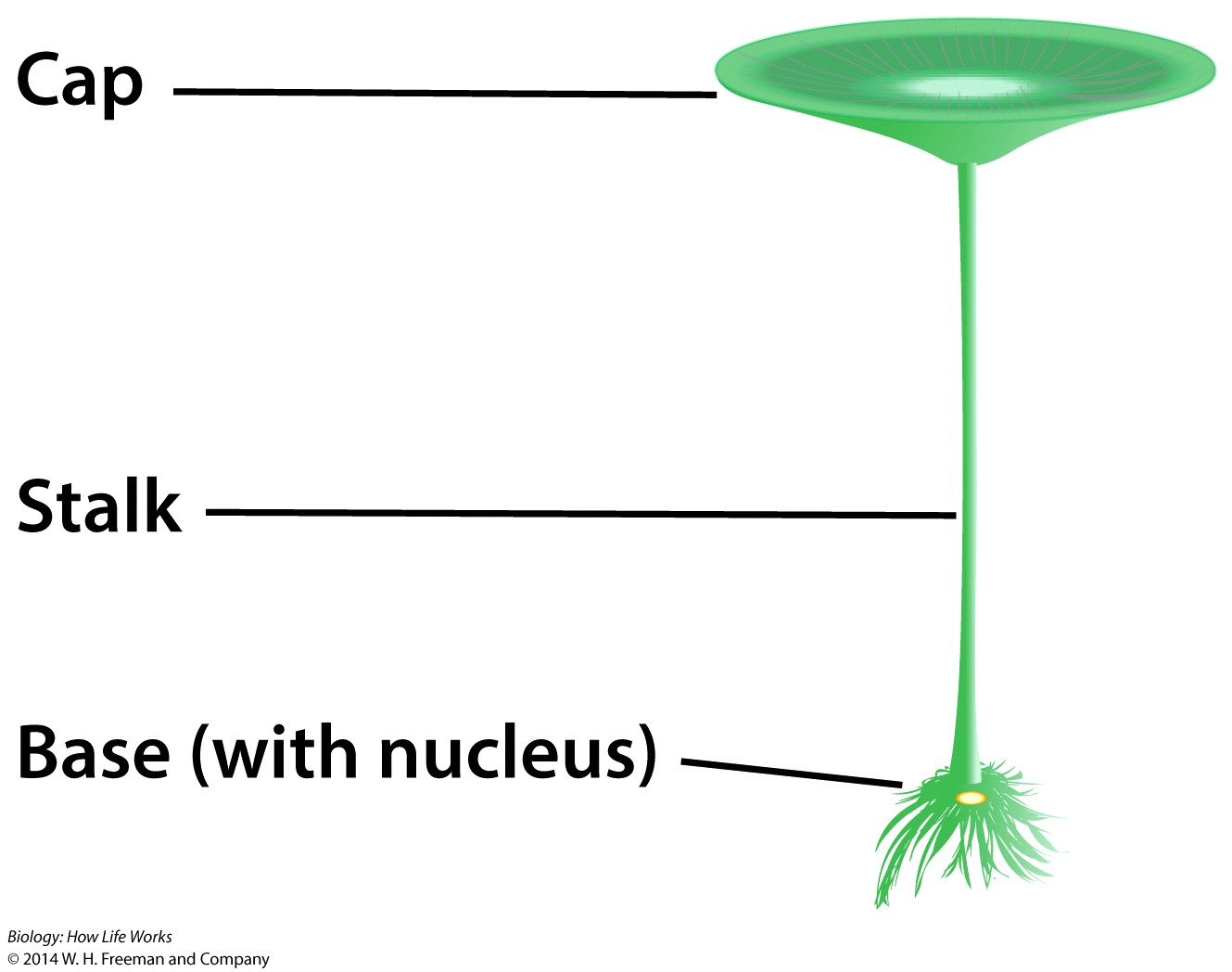
Hammerling decided to see what would happen if he removed different parts of the alga. He first removed the cap of one alga and allowed it to grow. The organism grew back the cap in the original shape. He then removed the stalk and cap of another alga and allowed it to grow. The organism grew back the stalk and cap in the original shape. Finally, he removed the base of a third alga and allowed the stalk and cap to grow. The baseless alga died.

Question
Mu0jiQ/QvU2sAQnSGKPky2kmzSIhqYgnUTNAB9ZpLlWt6mI4dw36AMaMKdloDJmigxlIMEOmuJIO/4mMoYURwbSSVZ6f3NKhEAgLnNcgcBW+jC7fONsgUBtTjV3UsnZBs1PCCSdxRENcF0/0hygng1OFw8npr/gT6BmGx2k9PZ+ueV/aavTkHDHzW4MneZjZ8N3qVUJWtiS8cumiVUkClzgScmgOpx3X3PgRDiTpDymK9BzLEBfBAr3xUhlNdZxibjmjgnDJ1PqlTFNvSPJrKEIimEl7t6Cofgu9qphjUPanpK3rPUpCsSl44T2Z82XJx2SlAGQWLary2aR0WETpnYfbfXYDX4xJlw97a0OLBhk=Question
38FtBMFNZmyUKLXMsN3rHREQGM/Kc33/8sCqTVpCHT8FNcVnhRDJGWedzQLnX66I1W/ey7jw9La1Bq48Jgzzgsg2mCAZkzOBXdl0QdI6JjX3T0Z5VhNybo+0ZZDdw7EqOy7M1CbPJ6IsSuSpfH5BgSxdrAcS7NoN26Kd919yOHV3YeSbPajEDZf98JF7zp0M6nFdGtVX5YEbadI8nuLncoUA3COMdFS5XpqLgcR8UwWsukBnExNLvROV0rA9QB86TkC+nz8nTTxlMrtlADzJKhKBv7cSH1hlaPZtfgffMDfJ7Pj/twlf/dwBjzGyxuG4With these initial tests, Hammerling proposed that something in the base seemed to be controlling cell function and the development of traits. He hypothesized that it must be something in the conspicuous little ball in the base known as the nucleus. With the knowledge from his previous experiments, Hammerling decided to cut and join (graft) structures from two similar species of Acetabularia (A. mediterranea and A. crenulata). These species are very similar, except that A. mediterranea has a round cap and A. crenulata has a star-shaped cap, as shown below:
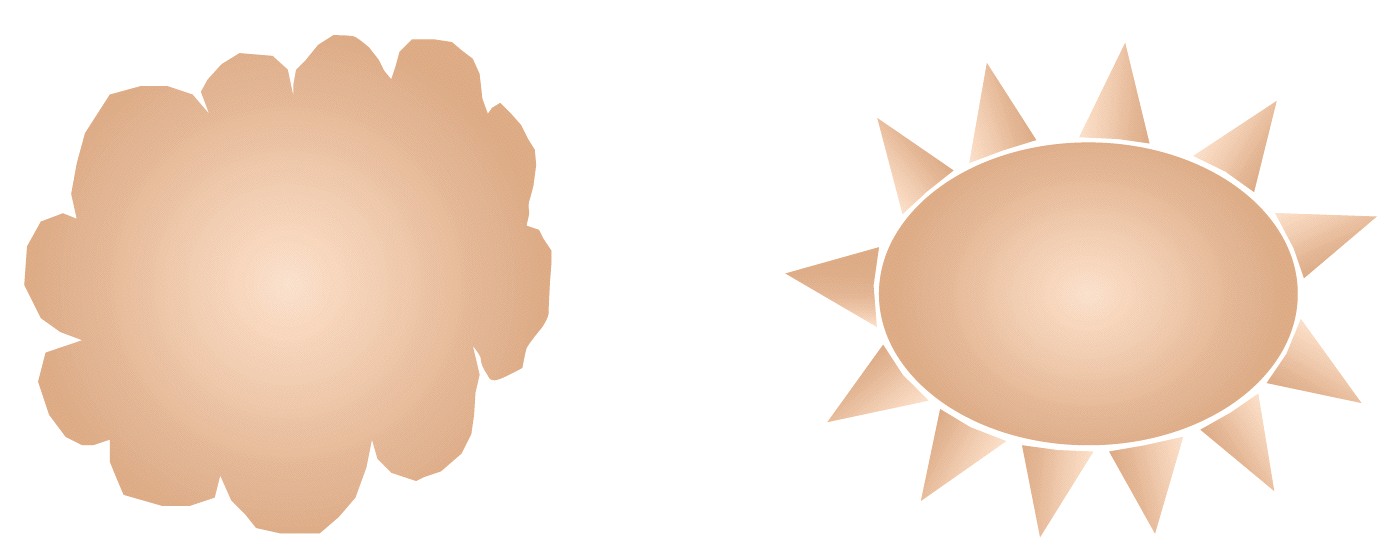
Hammerling used his initial organism, A. mediterranea, as the base to which he would graft a portion of the new organism, A. crenulata. From A. mediterranea he removed the cap and stalk, leaving only the intact base. From A. crenulata, he removed the cap and base, leaving only the intact stalk. He then grafted the A. crenulata stalk onto the A. mediterranea base.

Hammerling then watched to see what happened. He found that his hybrid alga first grew back a cap intermediate in shape between A. mediterranea and A. crenulata. When he removed the cap and allowed the alga to grow again, this time it grew back a round cap typical of A. mediterranea.
Question
JWrOcIgDGvqfIB5Rhls+qimHwwfZiFQRIXtVmte9Wk4GVDlI9Q8Qz7FQHk69Wbf8xRtZLQvPr0c7fdd9ggRwGWa6X8PIkOy8bXYwFpFXUoTGWJkAiL+sSaAc7TQwDOO8lGlU8ori+1VmXmKpRJz3f4sEK+P3QHmLFaevLPI+X1SQerxx90Ka8c+/m81rHRURTtc7mM6psOial9YfpBWd5MIvi4drjQjGjcZhqXIff4rCwcX/VW9NJ23jKGdGzjRHfSLUxmq8IBH86SBqhcsA9Yjx20RbzTuC76sVaepiXjoRvUh/Q+7inIj+BPrCoWdWQ2huJ1f4UHC1zU1TDMIQ2XKz5WLXcpL6ZJgNHgo66SK9482WWdiDHbpYxACWYoE2kco1hu7hik6A8LC/bFq6qtqqGXWpC23mXmW2xcLNncAWg2o8xQTVP/0QDbEhYIDxar0j0Kj5xY14GuQ1fwGovXPv1Kb0vr1lv5vRWw/L93I=Question
Iqn+ThbWgV9uUtY85jHRy4q7GSpsVHA62dek7QnF/J6hrd9PsqtDX7NyQtcctAC9i+1kTlzWYjPcKJ4om9Zw90eMP75dYRw8HQcQ5uobE108YCJIa/EeWIijbj0Ykc6vJKZOgxE3Q1flisJp5bTsfsOLoMxw6wZKE4Mr0Kr9UpQLYLSQTrucOQwplJ08Mv5/Ka4Pqr6see4V7pCD+rr/YjazAQ+7YwPzjrOcwv1aQKN4tUS/Xt1XyLIRS8e/SI/JyVnaWqBZ9CbQk1eVwX4ixD4jldw563fmCNRRF2KLsknBJwZJZ+VQgS15iD/YOIRy878W4Pu/7JeV6qz98QB7eJXxRKZyLKjb/NqNj7ucOcHHM6a3Yis+tb96md9nwLXYQV0ONlXwyiNP1296uWkyT3JsMVFQMqNI1ZkINGy54fuAmJcM7+qP/2Ugw1VUfwMga/efr0Hcp6KrrbbzTfrT9Tv2Z0Y=Question
U/HtVAeMvpIHVcKLcm3eSxyKDHfx7GVauvSkY+AXKibXp6CgNG1xvAahBUbhv5hI9Bs2YjVuj6+eeRpyfm6/SelWVmeAGmJ7agUiAZS4GzOfO7DEfwkQuWHjfISV439kiLIHiAAXpshiZbz45gOlllQrymIGi86xItcCOnLoMbWSCHoxoCWUFun+J3FIl54uHh8RI3S9z8+XTxBU5FIA0tugHb06pfgF+2Bv97h139HMn2SXJUavwcPDQjtgqi9ww1wzFnguge6LWji7kQAM8N4Z8XME8gRRsHnP6eANFM4HrLAJcwp704DmN7MRZE5aF5gDJGRasq9fhEB5NVjk4cQDo5R7PfswvjcbDNQuaQxwiXvlclRLCyS+0hMui/EEmPWyZ+cltCYoFH3IC1ueaSFsPQ5WNnjrd4aH1wQ8qsApR8wozDnPTNue4D1ttoszlpIR5QMyvXl3NfQxwif8mQjSPhPJCfxasiNrkGSY4G5qy4noaip8wktBDa3EmA4tJU8TB0W7+FfPRIzI0a4GE242Pf6DLsyWSXc+4csQ9ImhkZLEg9SG9IcokcVZDVQvoyzsF/JND5Sp8LjjcFSOlW9wYlR3Qgjy7gWT/kUO2r19f30cGpnR3QFIvMZ9/qnGtYQKYhROcnxnWta6aEPgRg==To continue this line of questioning about the nature of genetic material and its connection with the cell’s nucleus, we need to explore other contributions, such as those by Thomas King and Robert Briggs. Before Briggs and King performed their landmark work, Yves Delage in 1895 first wrote about a theoretical process known as nuclear transplantation (which currently is better known as cloning, or making an exact genetic copy of a cell or organism). Delage hypothesized that if the nucleus of an egg were replaced with that of another cell, development might still occur, guided by the genetic information in the transplanted nucleus. However, Delage did not have the technology to perform these experiments. Thomas King and Robert Briggs first tried this type of experiment, using the northern leopard frog, Rana pipiens, as a model organism.
Briggs transferred the nucleus of a blastula cell into a fertilized egg whose nucleus was removed. To do so, they inserted a glass pipette into the cell of a frog blastula, an early embryonic stage of development, and removed the cell’s nucleus. They then inserted the nucleus into an egg cell whose own nucleus had been removed (enucleated). The egg with its new nucleus is then allowed to go through normal development.

Question
What is an appropriate negative control for the experiment just described? (Choose all that apply.)
nbIRnRe8R9/OaJB+A. an enucleated egg (nucleus removed) without the introduction of a donor nucleus.
nbIRnRe8R9/OaJB+B. an enucleated egg (nucleus removed) with the introduction of sterile water.
3hMJDRP6OS+3EJIbC. an unfertilized frog egg that is allowed to develop normally.
3hMJDRP6OS+3EJIbD. a fertilized frog egg that is allowed to develop normally.
3hMJDRP6OS+3EJIbE. a fertilized frog egg in which the nucleus is removed and then reinserted.
Question
What is an appropriate positive control for the experiment just described? (Choose all that apply.)
3hMJDRP6OS+3EJIbA. removal of the nucleus from a fertilized egg without the introduction of a donor nucleus.
3hMJDRP6OS+3EJIbB. removal of the nucleus from a fertilized egg with the introduction of sterile water.
3hMJDRP6OS+3EJIbC. an unfertilized frog egg that is allowed to develop normally.
nbIRnRe8R9/OaJB+D. a fertilized frog egg that is allowed to develop normally.
nbIRnRe8R9/OaJB+E. a fertilized frog egg in which the nucleus is removed and then reinserted.
Question
Ncryb3PagrulnX4cq1HdrKHhDngs+OvnEvED0P/VK18t8mZIB2v45TQ7QyszB/W+irmSjJQUUqXaoCf1P4TRmSCkWaqeXx9RSSeiT10dKBr+NJPaXyuabhJCw4JySNLkjkhGYoc76c9HAxHo3A1vR0+gRJNg29F4HpFQeXNfPK4Gt+UPMSuUiwriO5mVW9klGtU0JA6Z/QVr7VFVlX58FjaqiwS2C7HDz1TlVAvg6ZsGsQ0bsHijYsaM0/oj+h69IbFNZ2JNxBMAKnFvhzSRFVQSYXfCYIc3/T7r8UtS6dsSSQR7jQrNNr8ky5f46A3Dvowu5SbUhQZo6aaaOXDs5NIfLmOrjzoK9pTnJwfKoOAbcXiI360e1tCEyrpWXN9MjC8+ntbuMiq+yr2OffuUuE+5gSPDN+A96dlMLFlnlvIPutuWQuestion
3bhhlNPtyLK/dMO+tPpd9JczifQq7W/3t+MsLYpWYuC6IUrmQrrEUEzQzcJAMlFwVF39svcYBg4d2lipFG06vqJUfmCj4VlURksw444R5w6gjABV/MgasQ7/OxYxmxWP6IqEM3kpj2c8JXuiS0g4t9D1F0WuRvHWgq+JIJtRujUHFT4uDsN7oXIcprU9FCxZOLg3VffgQiHFC0UDE2x7wPPeafQ+N1y1O32DH2UtWsivURJ792cuItkaoeW1RhpU7vXfbRVbwQaWVhXzDgwkkOujL2UHaomrj74rw//M50e1SB4qmjEsUsqsQqvxh+y3BsWpSCUy6a3QHc/O5n+Bal+DJoMBISVAGGOC4EtE9uZT7zvQhZKaBdtWzk7lzW5F+GqDZukkENow60n/96VCd/JX/6sHaUiR9PiX+s4u9iU7x9Zy4eqy+W1n6u048VIpxtq1/nCTKqsGw6vaTINieGWI3oknySf39055NQ==Briggs’ and Kings’ early attempts failed. However, their later attempts were successful. By the time the project was completed, they had successfully obtained 35 embryos and 27 tadpoles from 104 nuclear transplants. As an extension of this work, Briggs, King, and later John Gurdon attempted to transfer nuclei of older embryonic cells and even differentiated cells of tadpoles. Differentiated means that these cells are restricted in the kinds of cells they can become and are developing into specific tissues. Here is an example of the kind of data these researchers obtained:
| Age of donor cell | # of nuclei transferred | # of living tadpoles |
|---|---|---|
| 1 hour | 20 | 10 |
| 12 hours | 20 | 7 |
| 24 hours | 20 | 3 |
| 48 hours | 20 | 0 |
| 72 hours | 20 | 1 |
Question
What can you conclude from these data? (Choose all that apply.)
xdqz80TY1VwhogjfA. the ability of transplanted nuclei to direct normal development is directly related to the age of the donor cell (as the donor cell nucleus was older, normal development success rate increased).
nbIRnRe8R9/OaJB+B. the ability of transplanted nuclei to direct normal development is inversely related to the age of the donor cell (as the donor cell nucleus was older, normal development success rate decreased).
nbIRnRe8R9/OaJB+C. something in the nucleus changes as an animal differentiates, limiting and restricting the ability of the nucleus to direct normal development.
nbIRnRe8R9/OaJB+D. the results are difficult to interpret because of the low numbers of living tadpoles obtained in each category and could be improved by more trials.
Question
Mbam2VsNjX60QjiI2xj5G2FuQw9gT2eFzYxXhCalOpMamxPCBmm8AS7DLCRgidUeVkX0sw/K1uGZACV3bY7P5ZXk1BW0PS+kWNtCNbo9PiZGoovrpA5iZi+hkIcKjycfw3SOnScHlSs7jlIBMxIPwSUhK9zKOZAQ779pcF0Q7LgGCGwcWvfjy4V9aWKL2idbeUeBpecD3132mXnihgisECX3xQFJjyruldTokeTHzayRNDixpl5RLKB41Rnqa+6RJP/Crog9X2iJ5bLmsZChqYwDy5YRdoWars3XhXdxK7bs4pu8EEm2k0vlLo0k5OouBUn3N+v0smEP6jSXLKRz+qkgV3mXTlO2dQF7g0XvYv4otAUWg6RT66nK9OyB3u4saCI6lHgzm0hlcOckqlZwLXjJJ5JM+bu+1fbMcYSkb5FUcpGK/sInwfqOsLNh5/ugEdnuiPend3S8xSyO6uvKJJqNNV6lXx06FNDtVyMe+IB+F4x86Kl0IOpyN8R0jqxsVof4+5NpupiN4XW75Dh0p++zbNSw6Pkuq61ucDiPtOYXQPDVIvfAPopqZCKH2BocPJiGsCW+ntdjq/D6cMaX3z/3EikVjG4dFXRm/xhvNKr3L97Sb91h/DznosyIaeef9RcIsQMwqGKpNVAq0FYU7Pzfryp8lL507dNlfasXx8Us6YZ+AmsQmnuaU7gcz3FEg7iOqp2iT1mBA1uWDtDtUbmBnjP4/CAoiq1XboDQFYBSualgLRfZ77saWRFXIo0n5RxxXLrVzVqPmvBoibCTO1UXCpecUSazJhxEIh6v4QkIqjsTQxjMLs9b8xI=Question
WpKyDo7iDRbqsS9erLRc0gEfmfKq90e/rUY1zOMQvyY5Mydv+mrCtemQhueu7tx/RHZMdFSStEfDtAegzlcY/jlgBC/Ex9hYBwvlO6tfEDwF02Yj+Qp8n6VYkOrjve6LFZBBoDv0ixJZSyW+jlxVBpemjDF22eosOVq2ClZOwIEOjKcq4JZWpWgIaKn3rFVRSqHRDXKedmLO/cc+2IWeEzChi/7d4ij+e7xECK3HwFsDV4PbwinkAWwaVSXW7U6tGUG7JHroHlhYX6xH6nsR+zb3935uKcB7XsCzqxbqiMXfSaCyRBEYm54gfyDYcSUElPIAkthCJow9CzvDcBpkDrEQs9R42rISEFfTO+BwLaj9gnwIjJwlrOCAnnjLGOnQuZ598tlMK/NmkRcgHGBzUnqz2pBQxSR3d6gj20fgAt81vtpI69ikV1O+ef9igiWDCAPmF3vXOAQ=Question
ra6vbww20h6v5jO9bMRRM73JIgo+djXnjJTYglXxD3GQDJUqYY7xFyY5gwf3UJqMx/20KRNb7/HYb6Oce1NstXRx1xb1k86LNZl+cHRyikvqqTunJ3BRi9GlPXAgiLQYsP9B+58T3obYvoLON9FTHNSrAZ8pxxnSfp2W2CdY3eHU2mK53zKhr65xS658skNsyP42BOsT9xdN39B8+RLWrhPqGjfe9mR8drmJdECwFTTwiLVYFvbZ/XsSOfmErngSW/89eE22Z9oW5c5JaKYIEJ9kZ7phsmtpphpmT3CiZSpJB3ltXOWYasoMo09CQyY5OEEdXeBvYP3z5H/jZbRxZoBjMj9K5HtFyPlbg/baN7HYTJxqQ32bWDx5Nk0GbfITj0PdSqOhXMtz9MF03ALMfQLG/BTlxGxrT02EfWP1hOG83wJvAtrE8XnNMt+DORpuGqYZOLUx14X4GGxWkYxFBEoJP4Ecd0qym6cgeAySp58g9IfGaZM5/4Y3b8N4DJ8Zou0r7DITnXI1x+oJ+0DTArEB6hxobr4kC5SWIWcC5ePmvKHKDXoNhaXh5Mkkwx002yKJas4w9ZaOHhMO08lSchBhKYe10ybgp8rv5leRxVCZOReGRaazqLxjKfReuwtJl5Xmb2KNTWKcoRhOEKbyG6HoD3anC9XaxPjbwL9YhQ0+OV8C5eDCC2JJrPzddB5tv9I9v2uQOK0Ph/namTOX7t4U4UckKS4aAR+5MMR/LKFqGD9oTFRwOGPxNum58i4l/wou11QytbCVzxMBp5wYHF+XuKjCLgH8wzdhk2US75UfRie6CQe+/kKvdfX/96BuC6n+GyN4wIolzdrvB2jGUnGp/QgJ55R9gZ/OvrtZesv7oEw9SFGFQUMN4Bx989421FMC5sLlu01htepTkw5UBgwyBM2xkwI/KX9ppFY5MmWbZpy+adHfwfcP0SN+KIDhLdkVWLtmrvatczNvTx01FOY0k//RWozOWuqgVLeNcnh3yDTejcyU6DrYRfYsF4uVWVsuUR2sFDNFcsgVQ7Mbuk+F1zdvczYZ/8nanZED7kHyD/O1rB3LB748EHlowa5gPart 3
So, how can aspects of this scientific field exemplify the nature of genetic material? We shall explore this question next and see that it is an extension of the seeds that inidividuals like Hammerling already had planted.
Prokaryotes are types of primitive cells that lack organelles (specialized membrane-bound structures which perform specific functions for the cell), such as bacteria. Because they lack organelles, their DNA is not enclosed in any structure. This genomic DNA contains instructions necessary for daily function. In addition, prokaryotes sometimes have small circular pieces of DNA in addition to their genomic DNA. These are called plasmids and usually contain non-essential life instructions (please see below).
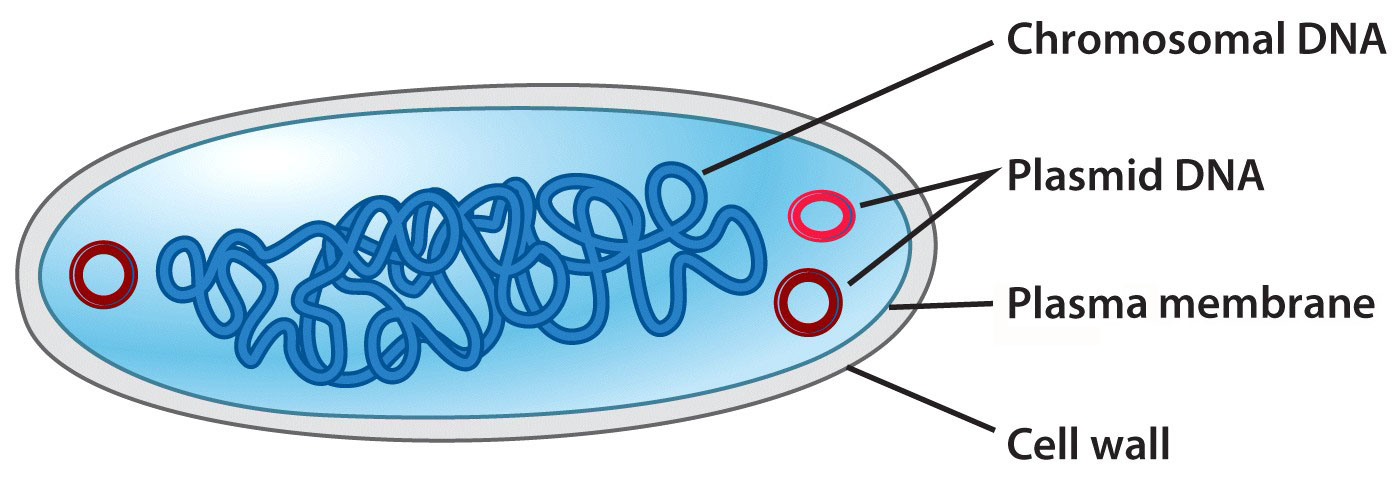
Plasmid DNA can be released and then taken up by a new bacterial cell, or artificially manipulated and introduced into a bacterial cell in the lab, thereby giving the recipient bacteria new capabilities and traits the cell did not originally have. In other words, bacteria have the ability to take on stray pieces of DNA from dead cells and its surrounding environment to potentially improve its chances for survival. For example, genes that confer antibiotic resistance are often carried on plasmids. The process by which a cell takes up foreign DNA is known as transformation.
Question
ytohL5co9Wrcl9ENuDpT7J5w3SB9F9DgTVmFSYhmxtU9PaXcYotlSymTxzhm9Zhm5bapbvq1/MxXauDNtXublEbH8t2CXCXKqByl6+PWMVHAgO2kZx11/Tu5CX+bcFH1EMKGMGSkefV3P9+oj5LIBKPFAIKj80HVHx0iYpDPne5y0xUobqerJKaVFzmZP6uvztSw1leQ/BKIhIZGdmRiB8qFm98fqBRtwlKpiJvLNQm0/4ZKNnn74VljRt/XJ9I9VXDnrNnJT7+G8SXcHEtkcRn6Wm/NjniHEWu2pNBGAlHYSKbjTwWj5Z4+Lzkex9NFZmFI6LVmSJ0ylKmyuyIdYHtzLGU8sIGj6uDivnNiKUxNoPquw63HmLcTaCu14izDGAP4/cTAmp37cAmFTP6+CNGoLOzIQB8o7NCWV2/56ozIu2T8jR84nGB6hotP2b12o91wfjyjqf6zy0nSNiTJaHZgij7mng8B5fS0fTGhAqkCihRpYjWT6mSBv0ZmlpMocF49pV9SmAIKBWXnrnl5+K0tU2h4H7VHEukt2xWBJwFcTkQQ8cUZ9Zn32UjE7O3F5lKDYqaA498DNda+L1a4MFP7ZaVr9eEcMOITGBjzy4intEyByD5PumlHEYzEEYQSdeYBVermKCzhmRK82ZWUyE++Y45A9IIWSAviTPvJlrWtVyXARnxEgxSvyqz1zLybPIMQemhOmM09hy86ldLPDmQKUZitJ6xULI1dTjbHjKMy0/3bqztR9umIYhcwuW8PpG/+wzzU6wFazBCcum+vwXtrp4WdPB4Dh8QWfzA85XutK+vEjmwULYQ7raAtj84KINz3JtP2iDDCmg+Pdl6ndkySmlxdA2RaTHzwJa+fteg1cOVn40eGCEiYzXAc9ozlIeidzX3GkQcxh2kIeIC3AGfJD0GClp4FnLwOJjwVSwQmEoUO3WSAcF764SnmTKGk
Question
xnxVXIsSP0woIg3IkdWsJpq9eFzuuBkAYZE4GuBFkLm/qKlTzehF2ktalaOqadGJBLbKNx5ve1AiGHT8tArjOCam6bEwvdY637cedCaq+chF6HLJsVu2FrzHyN1R+3y+E+RxM2oN9Z2VG1TxC0U1vH2/41604heUpgs8bQgdx9Q7a5ODHqgZWk+KUl059HrOveh0I/MaFur8X0LAa25rmC7QiFAuopczZQTYWkp8848wu/f5dxIZjg==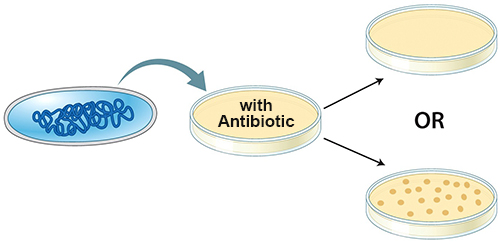
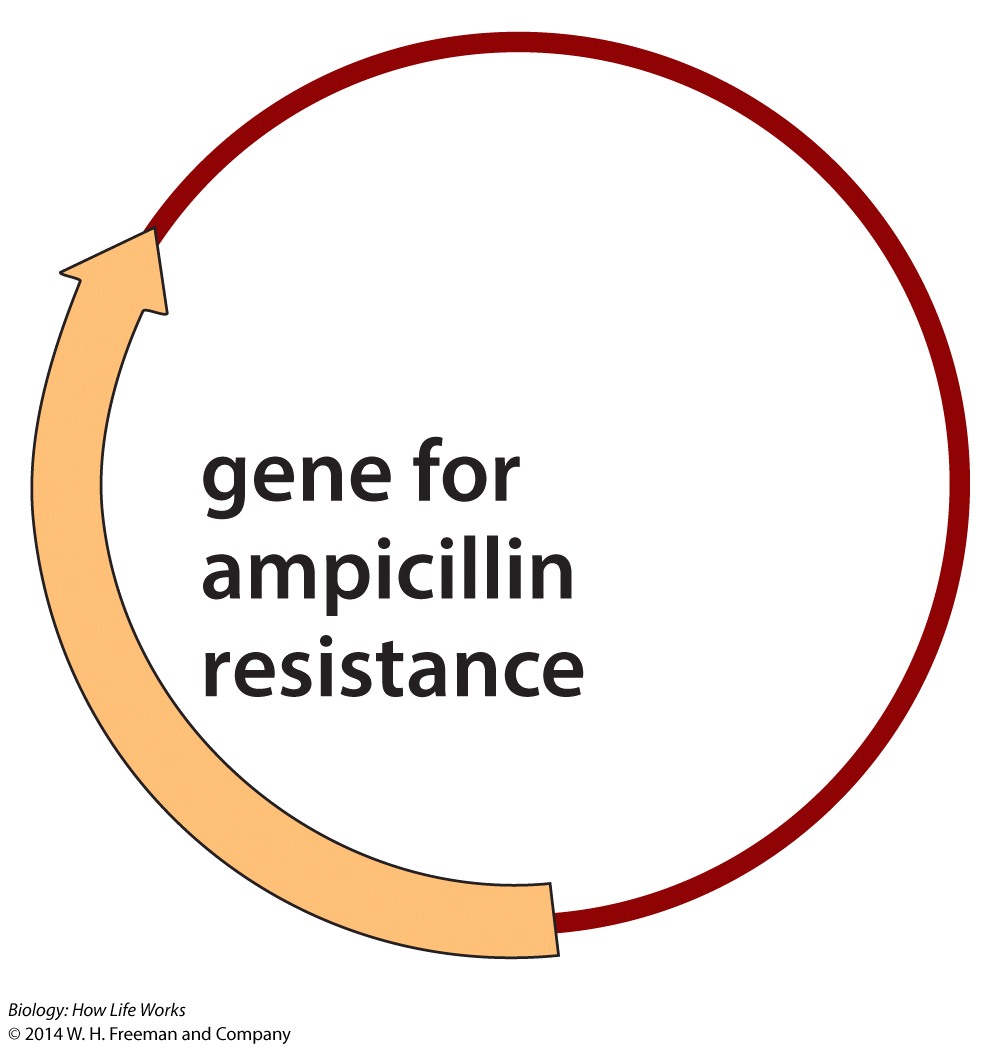
Now let’s introduce a plasmid into the environment. This plasmid has a shaded region indicated as “amp.” This means that this plasmid has a DNA sequence which would allow for resistance to ampicillin, an antibiotic. This plasmid is now transformed into a bacterial cell.
Question
GsUKJpeLFFOIQ3z4uxw35+buGXu5c1BX2j8q6DopzAm5rgjEgYGbom7FNqWLh2YLzt7dwePJTWJRh9rUaqHsngiOAknc4iPxZnQ/llKrHKx/juW5z7Aysm4SSOkk3GyrLlDtc1Mt7HgSOl5XDECRJDgLHBjRfhC5nQU8NCHXkjK/J5itnEOIc2TbxVH3/vNUF9hb1d1j4G7nW7vw7cmJZa18JiV5RytmRJGw8bmfJ+/UKYZpRuqDIA==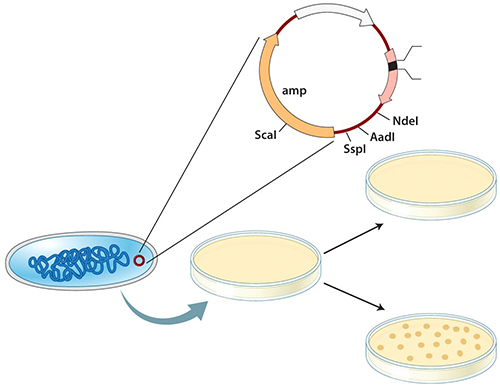
Question
GlfcSHiQzIbfHFe2AFvtsi53pzzpwrO8nw6g1bAakp08HgBHW5zfgb4A6H8BhnWQCCDHMD9Ccw5s1RwFrNM3khqAJXRyQeXEZJn9hbwL+Q/usKw/s9+Zgp7snbkyBsq74JLJddiHARso7W+xZ6HDume9F/bXqyDzXbuOBMtO3ev4v4vv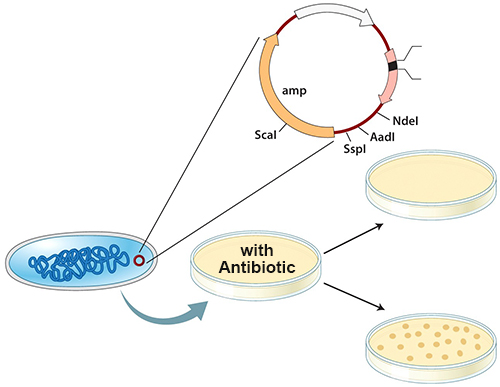
Question
tQUcclSDFMxtX8l8MyBQfmjg0+ruH4/Ea9GcDmwvMssqZtFk+Ox1jQP624o4lwFuZosoBaJEZDKsgEFPraJVYnHqr0BkJqVD8MEvndil0FQ5E9W7JPRoWcNA2XVvnrZRnDtvN90ay7JuRZYz6cQirh6r+GAAkejGcmMXFEj0tP+kyVfSQOrJ07FjhOCLHn38G9poMiivkDrueir6i5oXkwjVYU1Kyi6JyVzcnsrDjPYwHQG5p64hJTLwpwP7B8Np7UeBN8FldWtlJBs5wBEWlKSDEJbZKIr+tvXNZEWMe7ITpz+3JUhN/G9aCns=Question
U5ORWChrLD76N5nunxQylqVPKbu0A4Q7n6+jEJ5++hwokrd4yCXv3bGpuV4AkACQQlcEZfvSOJk1lVtTgmz/ePQMzGWHn04SYEsuPusCwl52LAaI+uO4qQvPHv4YcVisSa1xIhT4uuQsMz5U8QWk+tUhmJR8RYg3yPE9Jj3FrXfPBO7Gdnf1pYd/wVyXpHPJoa7XxcIUE4a+00qLZd93tj3ZzzAWhbdx6+akflnmOYUKxvfp+/zR8xYh4M4w9b5mQRSprqF/o+0ysAk31DD0s7e8GyPaqCSW/n4BnySbdlX/jQuJRGH5nEq7Efrzi6R+HONaGHuxUs7AHxfpq0iVL6W4eQ1NPCA+/ja4xTpUeyqGbOoLQuestion
ktgPhMNzU/m1+lA+qR6/3Z+Wgoh7xat1kBhb5QsmUvpDFuMlvBxYIL/qSTT3cJ2Q88W6G+koBFnKxrhIqAXLC9QQdcpZb2Jd6OaDnGH2Shhijuy1ynalRaty1VUe49lud6G7A+/28NIds0hR/ewt9bqY2tZWMo3bT9AXuUBDRNUGsSnoNzUfJurqH8g1rrbCtFEbY0phjbPwvnNbR+5zU9Gx/cMM+l0JjH5VNfDjt6fW3QiIDoMwFhkhXoA6xYHAwK0sAaWPDi/Lj52PwXKua6nJJd4l6I3Pz9mn0ifvX/wQyvXruXTuF2OFs7Lm5HHrB0TUQXAPOl1c/46ZwtSEPeu82GlFo41BI0+Jze0JaW5GounpOgLSwRPAe+2JIpzfglSFQXfw0RbP49xC8FZGkjEiPcIMzKZwjjDf8WKEExINU1DSB0QMeU0CCZx06yt6oii1MelpqzOqp2KL5FRjW++XucUI9D79rC9oupJ3304Ry/9ORSl1xDOPLKmKtw78Zek0NKlkY+ZFrIcOZL4F4uh75ngsn3GZKp6QaxySVKqzQzvJlrg7Mwfi0EiBu3rC+scCHJkiZcb9IbOgQz9IVeq5e6h1K48A2VknGthfu7kNO/qKBFgJk9bxvjEUKrgY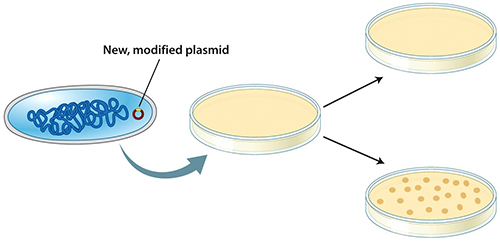
Question
f+1vxdmVBADKrSNrLjjrDBpJazld7rTvSkv86R8iCf7snt3IaX+FOpO+IaPnNOug24CnPKDKbbcL/szFXJRp+91+l0nAn1xuUVkGxhZ5Oxo=
Activity results are being submitted...